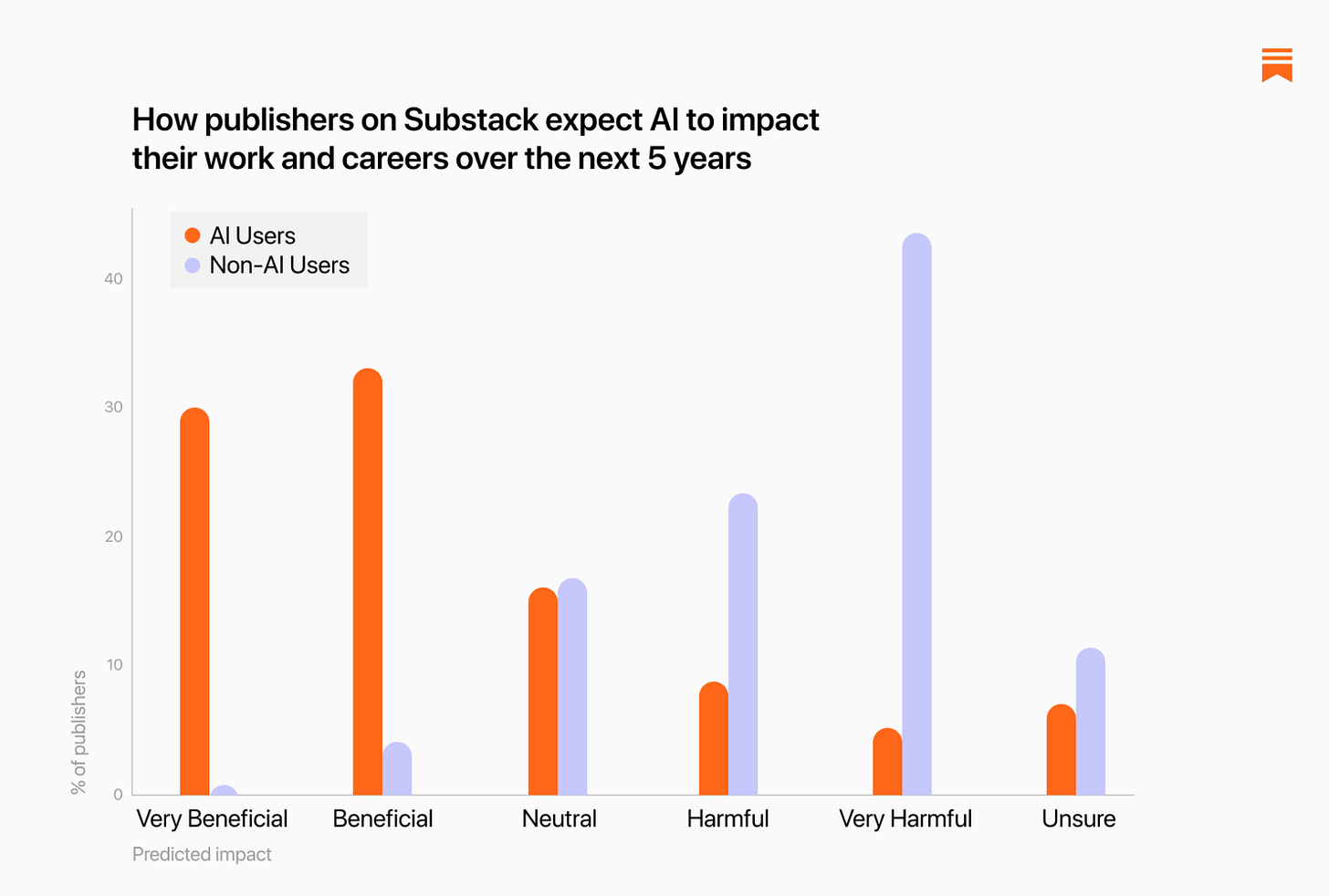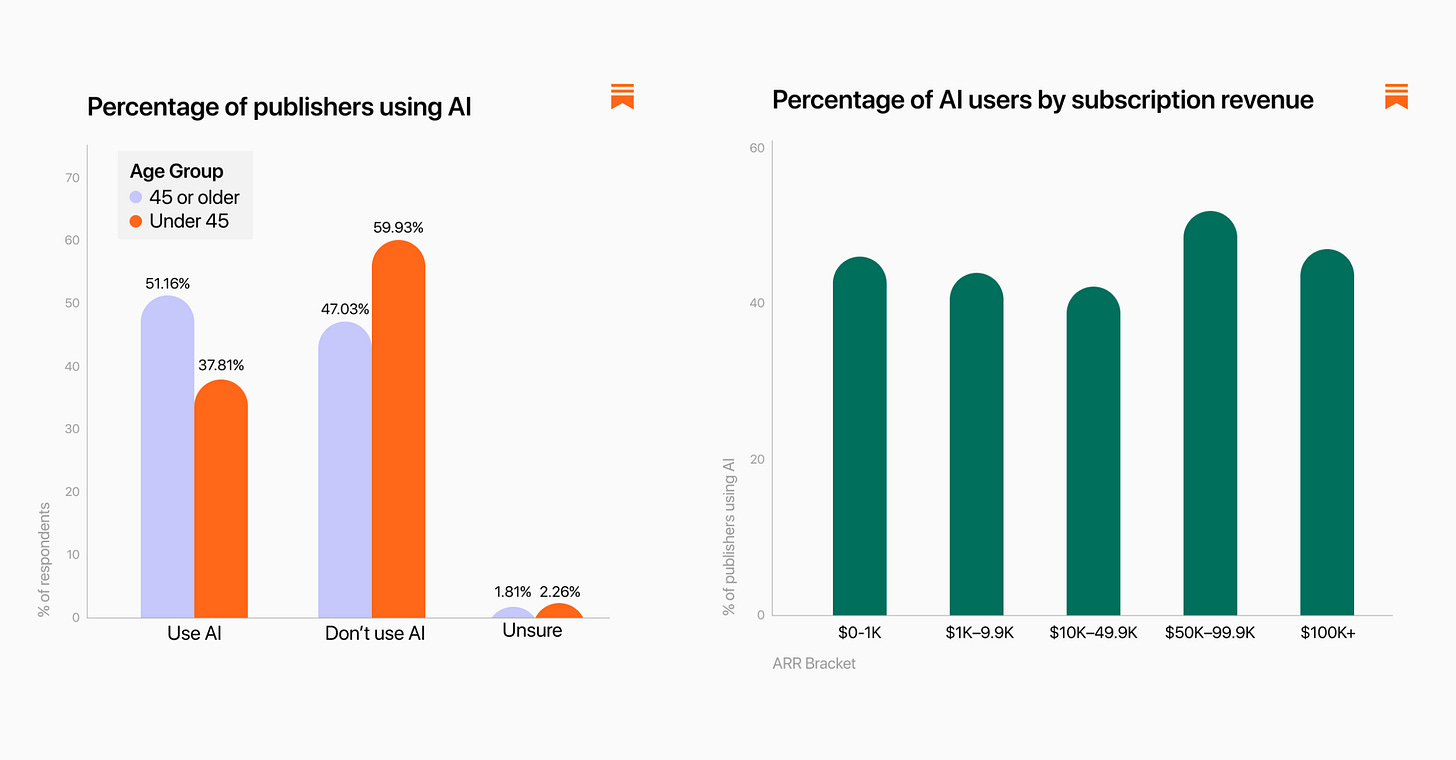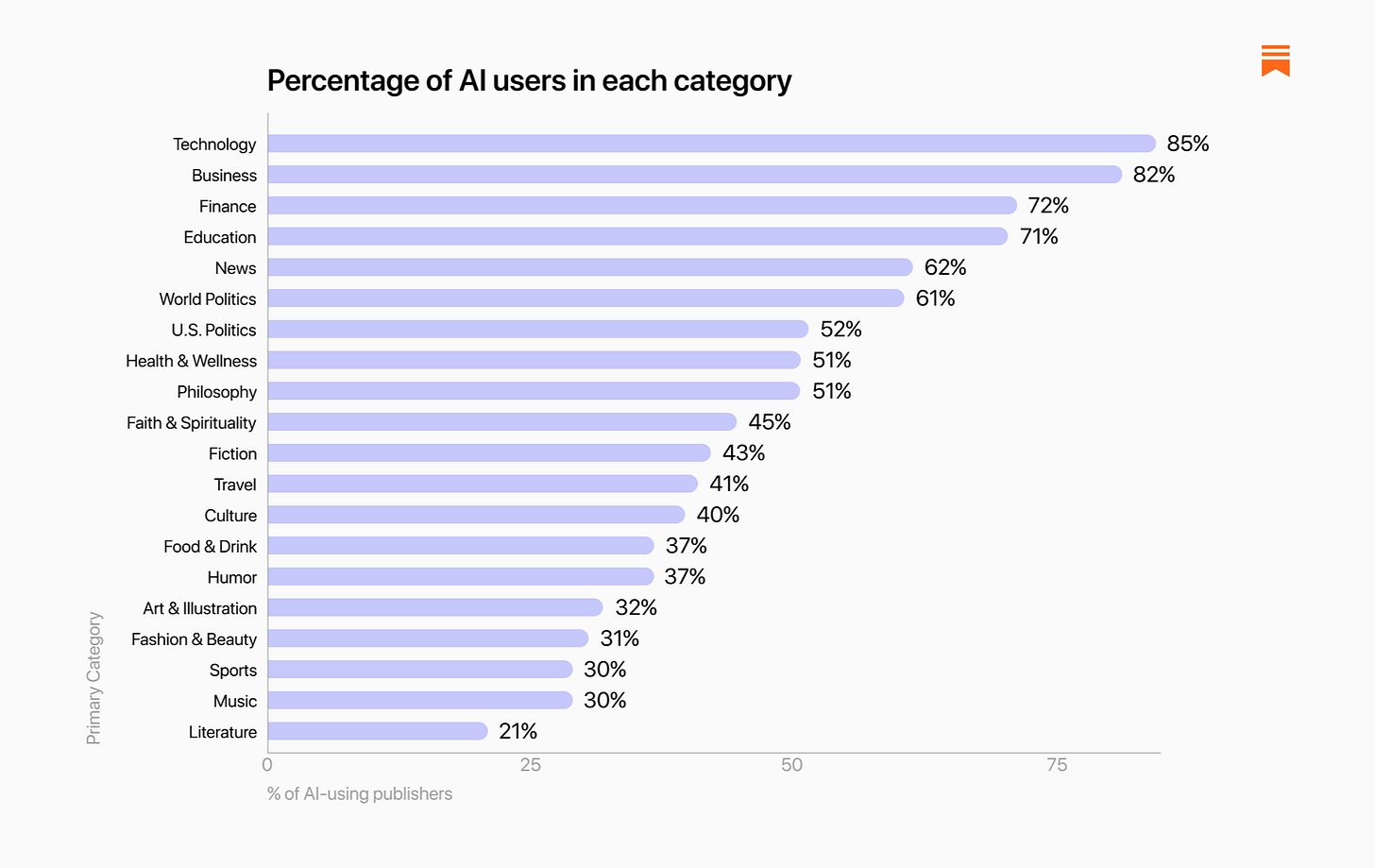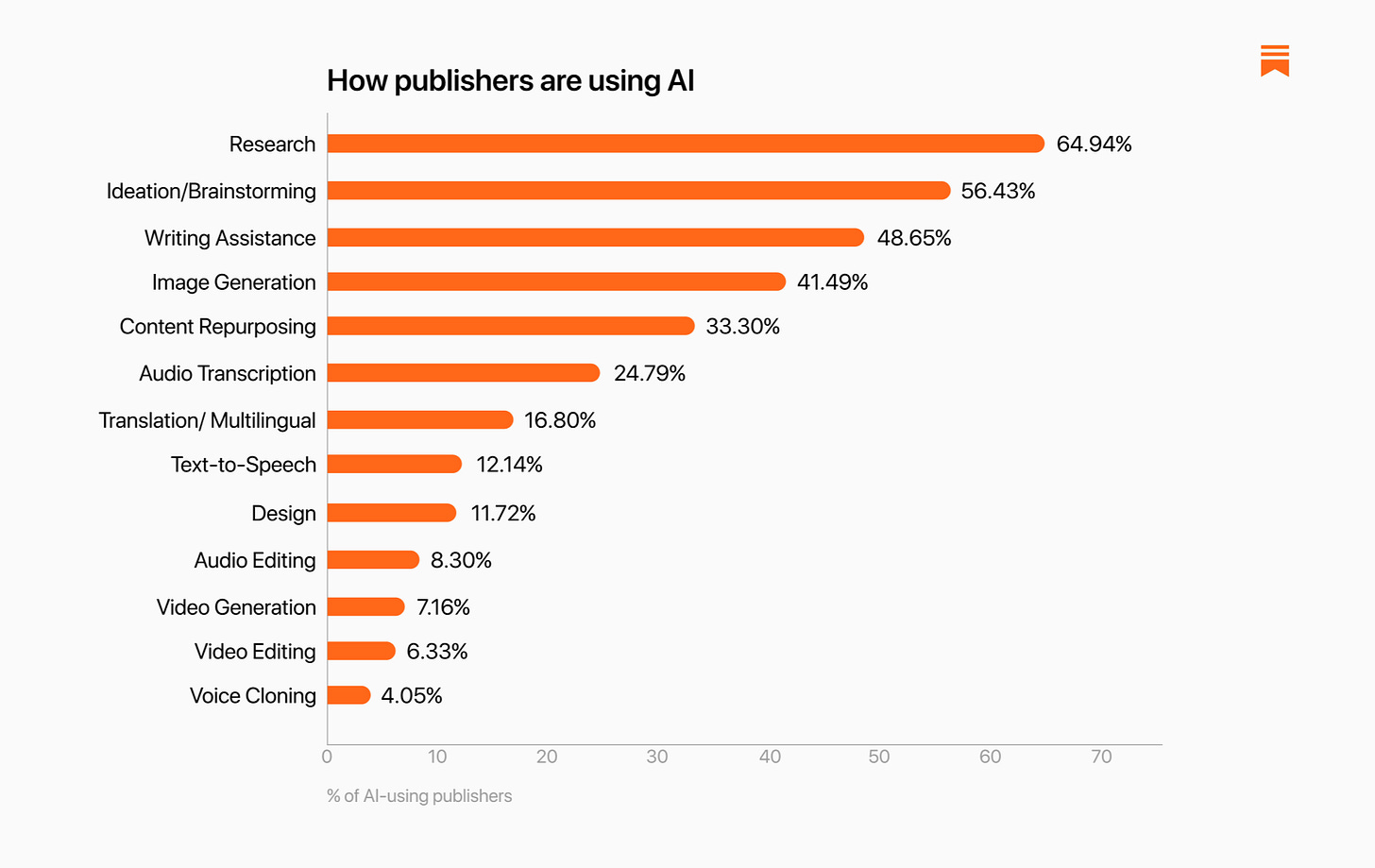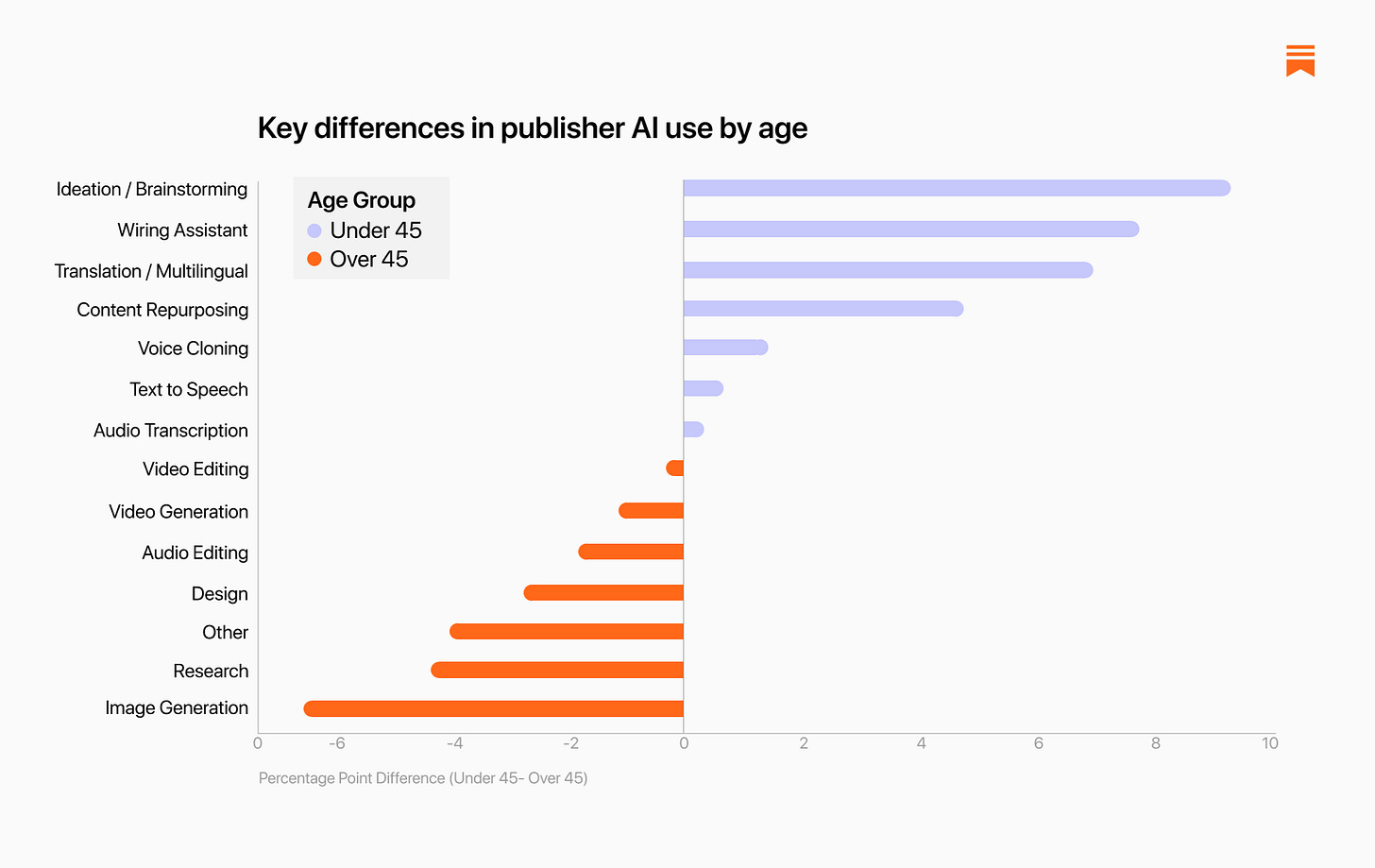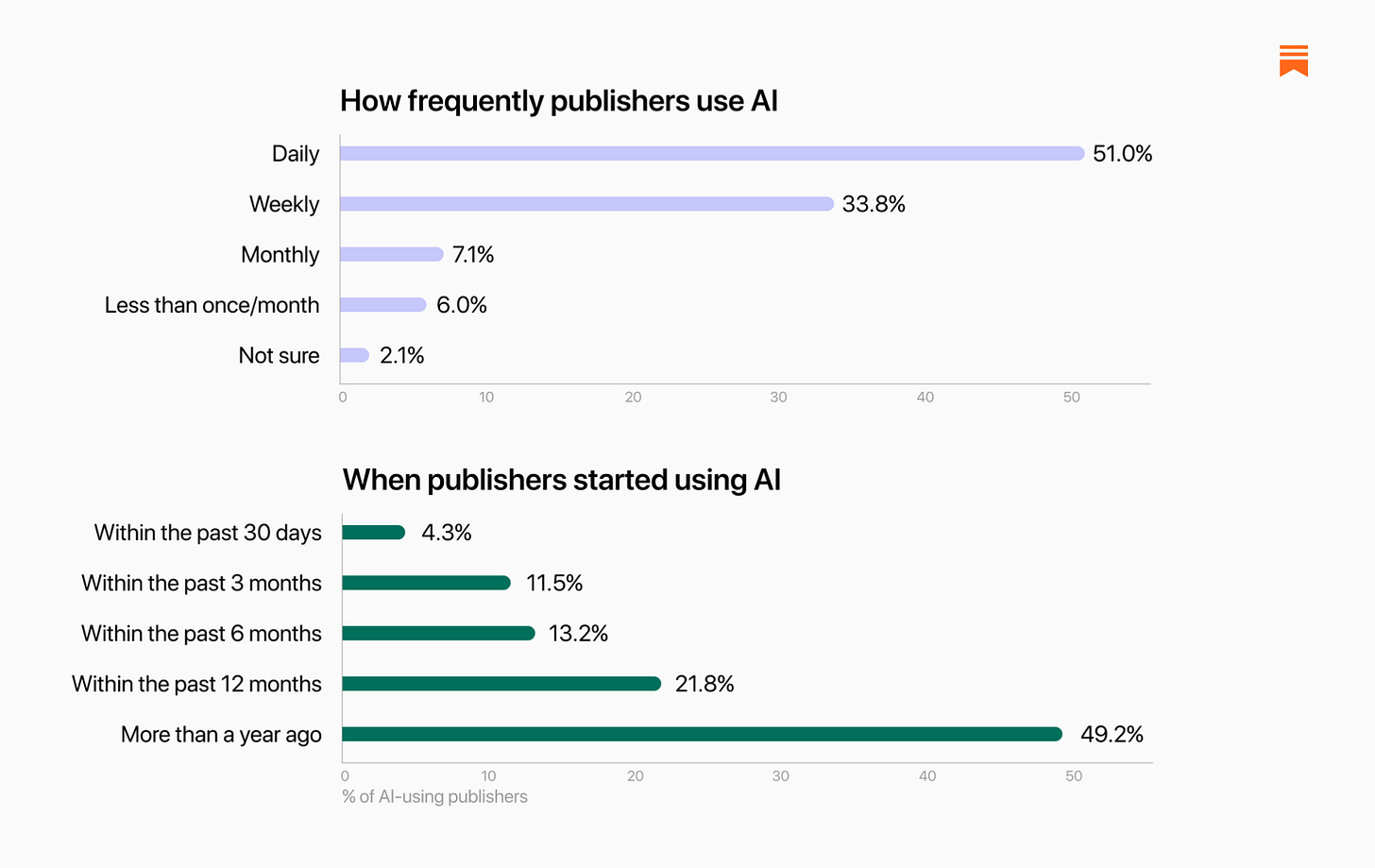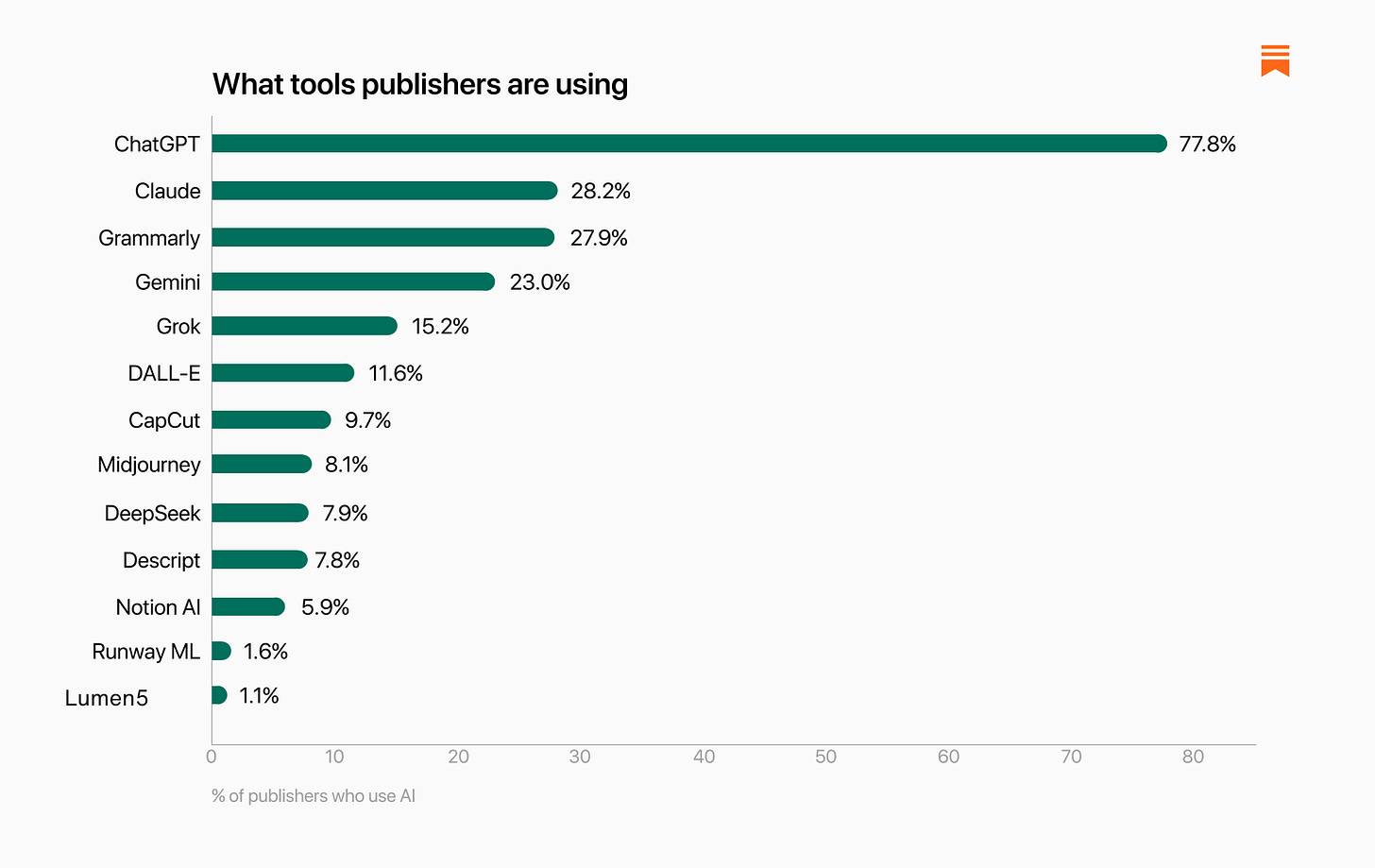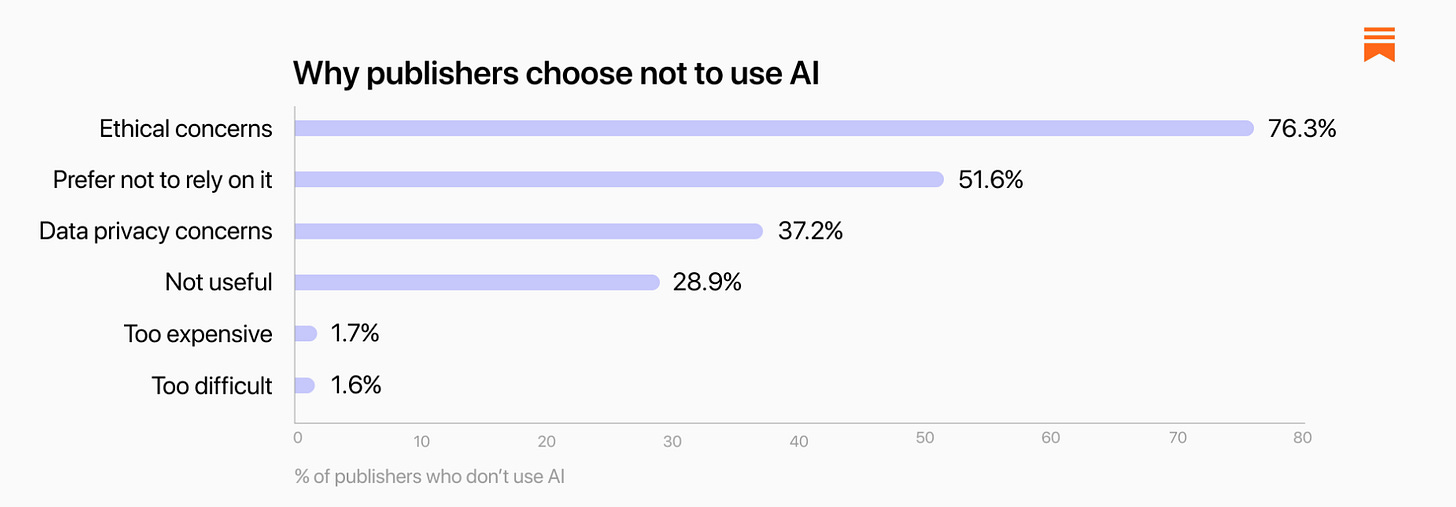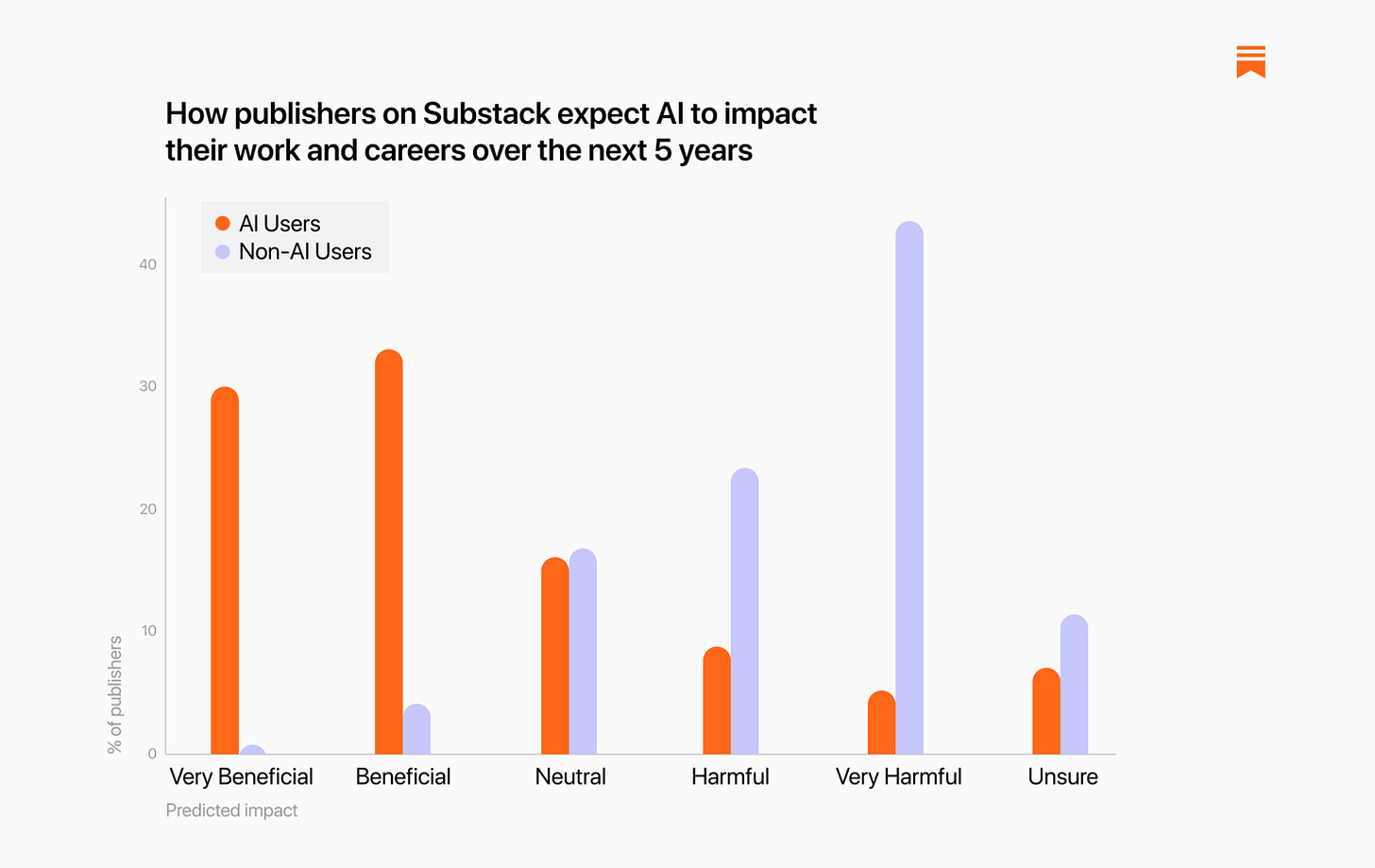The Substack AI Report
We asked 2,000 Substack publishers how they’re using and thinking about AI. Here’s what we found.
AI is here—at schools, in memes, and, yes, even on Substack. But beyond sniffing out its usage—who’s being too liberal with the em dashes or the “It’s not [this]. It’s [this]” constructions—AI’s actual applications in creative work are hazy.
So we asked publishers directly: Are you using AI? How, and why?
Who we heard from
We surveyed over 2,000 Substack publishers, including writers, artists, podcasters, and video creators, from around the world. The survey was designed to reflect key segments of Substack’s publishing community.
Among respondents:
21% were bestsellers (with at least 100 paid subscribers), and 70% run paid newsletters.
There were publishers at every revenue level, from those running free publications to some earning seven figures.
Most have been on Substack for one to two years, with 20% reporting four or more years on the platform.
They publish in a wide range of primary categories, including Culture, Technology, Literature, Politics, Art & Illustration, Humor, Education, and more.
What do we mean by “AI”?
“Artificial intelligence” can mean a lot of things, depending on who you ask. When publishers in our survey talked about AI, they were usually referring to generative tools and large language models—the ChatGPTs and Claudes of the world. But AI also runs quietly behind the scenes, embedded in familiar apps and tools that aren’t explicitly called AI.
That ambiguity makes it harder to pin down how publishers think about and engage with AI. While the public conversation often centers on content generation and its implications for art and authenticity, publishers on Substack are often using AI tools in more varied and nuanced ways1.
Who’s using AI?
Out of about 2,000 surveyed publishers:
45.4% said they’re using AI
52.6% said they’re not
2% were unsure
Based on our results, a typical AI-using publisher is 45 or over, more likely to be a man, and tends to publish in categories like Technology and Business. He’s not using AI to generate full posts or images. Instead, he’s leaning on it for productivity, research, and to proofread his writing. Most who use AI do so daily or weekly and have been doing so for over six months.
Publishers 45 and over were more likely to use AI than those under 45.
Men reported higher adoption than women (55% vs. 38%).
Women were more likely to express concerns about using AI than men (67% vs. 47%).
AI adoption didn’t correlate significantly with revenue: usage remained fairly similar across revenue levels.2
In the responses, AI adoption varied widely across publishing categories3. Technology, Business, and Finance had the highest rates of adoption, while Literature, Music, and Art had some of the lowest. A 64-point spread between the Technology and Literature categories marks the widest divide in the responses.
How it’s being used
Publishers who use AI bring it to a diverse range of research and creative workflows, from summarizing legal filings to parsing data to optimizing their work for SEO. Some have even used AI as a virtual business coach.
Surveyed publishers said they’re primarily using AI tools for knowledge work (research, writing assistance, ideation) rather than for content generation. Of generative use cases, image generation was the most common, at 41%.
These publishers don’t always see LLMs as distinct from their innate creativity, sometimes describing them as a kind of mirror. One creator said that the tool “remembers my way of articulating ideas.” Another wrote, “It reflects back to me my voice and streamlines my creative vision.” As the tools become more attuned to a user’s patterns of thought and expression, the boundary between creator and assistant begins to blur.
A number of publishers described AI as especially helpful for accessibility. “I have several disabilities, and AI helps me organize my thoughts cohesively and streamlines my writing process. I’m able to brainstorm, refine, and keep a schedule in ways I couldn’t on my own,” said one publisher.
“As a dyslexic with ADHD, it allows me as a round peg to fit into a square neurotypical world and for me to be able to express myself.”
“It really helps people like me, with ADHD and dyslexia, to thrive on a written-word platform, which was very difficult for us without AI.”
“I am blind, and the applications of AI for increasing accessibility are enormous, so my views on [AI] are fairly nuanced.”
“I have ADHD, and using AI is like having an editor and organizer for my thoughts.”
Language translation also surfaced as a notable use case. Nearly 17% of AI-using publishers said they rely on these tools to translate writing, audio, and video across languages.
Respondents under 45 were more likely to rely on AI for translation. Younger publishers also said they were more likely to use AI for ideation and writing help than the older cohort. Those 45 and over work more with AI for research and image generation. Audio- and video-related use cases show little variation by age.
When AI-using publishers were asked to estimate how much of their published content in the past three months had been AI-generated, “including AI-generated sentences, paragraphs, images, and videos,” most reported that they hadn’t used generative AI at all, or used it sparingly—though there is a small cohort that reported using it in 100% of their posts.
Nearly 85% of AI-using publishers use these tools daily or weekly.
Which tools are people using?
ChatGPT’s first-mover advantage still shows. Nearly 8 in 10 AI-using publishers report using it, far more than any other tool. Usage drops off from there, with Claude (28.2%) and Grammarly (27.9%) as the next most commonly used. Image and video generation tools like Midjourney (8.1%), Runway ML (1.6%), and Lumen5 (1.1%) remain relatively niche.
Many publishers independently named the AI-powered research engine Perplexity as a tool they use and love.
Several publishers expressed interest in tools that could help them better understand and grow their audiences—specifically around analytics, engagement, and audience insights.
How do publishers feel about AI?
Publishers’ outlook on AI is split sharply along usage lines. Those already using AI tools tend to be much more optimistic about the opportunity, enhancement, and new creative possibilities for their work, while those who haven’t adopted AI are far more likely to expect harm or disruption.
There were some points of overlap: both AI-using and non-using publishers voiced concerns about creative skills, plagiarism, and the environmental impacts of AI.
But on a personal basis, publishers who use AI overwhelmingly said that it adds value to their work.
When asked, “Imagine you were prevented from using AI in your work. What would you pay (US$/month) to regain access?” the average answer was nearly $140/month.
Still, slightly more than half of these AI-using publishers said they have at least some reservations and concerns about AI.
Many cited fears about AI eroding their creative style and instincts. “I want it to still be my voice, and I’m trying to find that balance,” one publisher wrote. Another said he was concerned that he would “lose my voice and my story, which is what people are here for.”
Ethical concerns were also widespread, especially around how AI is trained and whether original work is being used without permission4. “My novels have been pirated for AI. I don’t like the stealing of the IP,” wrote one publisher. Another said, “[AI training] is stealing content from creatives like me and creating derivative AI slop.”
Ethical concerns were also a priority for the 52% of the surveyed publishers who do not use AI tools: over three-quarters of them cited such concerns as a reason why they choose not to use AI.
These publishers were also concerned about creative atrophy. “Creativity is like a muscle. You have to use it or it withers away,” one wrote. “Outsourcing your creativity won’t help you in the long run.”
Publishers saw how AI could boost productivity but reflected on creativity as a fundamentally human act of emotional and intellectual transformation.
“The best part of being human is taking the time and energy to wrestle with complex emotions and information and turn it into art that inspires, uplifts, and makes other people feel seen and known.”
“Only a human who has experienced, seen, or studied the things he or she writes about can craft a factual and entertaining story,” one publisher noted. Another wrote, “Writers are willing to make that effort. We don’t need tools to do it for us, and the existence of these tools threatens our employment opportunities as well as the perceived importance of the work we do.”
Looking ahead
We’re still in the nascent stages of the AI revolution, and as the above chart suggests, there’s a sharp divide in how creators are thinking about the days ahead. Transparency around AI came up again and again in survey responses, as publishers raised questions not just about whether disclosure is necessary but how it should be handled, and what audiences should know.
One publisher had a particularly lucid vision of the future:
“We’re entering a spicy new era, where human-created content will be ‘premium.’ Faceless YouTube channels proliferate, and countless Medium articles are written by AI without disclosure. And we are only just getting started. . . The speed with which the tech can create passable content means that we will soon be inundated with machine-generated words. Authentic human writing and video will be sought out and prized above the noise.”
In all likelihood, the future of AI in the creator space isn’t going to be a binary choice between “AI” and “human creativity.” Instead, it will be formed by thousands of individual decisions about which tools serve a publisher’s individual goals and which detract from them.
And as AI continues to impact creators across industries, we’ll continue to host an open, evolving conversation where publishers can gather intelligence, share insights, and make informed decisions on their own terms.
Some of the tools Substack offers to publishers are powered by AI. These include automatic video clipping, which generates short clips from uploaded videos—with the option to edit or create custom versions—as well as image generation, which allows publishers to produce visuals from text prompts directly within their posts. Substack also offers automatic transcript generation for podcasts and videos, enabling publishers to repurpose their content into clips or audiograms more easily. All of these features are marked clearly in the product and are optional to use.
Among publishers earning over $50,000 annually, responses carried a higher margin of error. But AI usage remained close to consistent across revenue levels in the survey response pool.
Although these findings are not perfectly weighted to reflect the full Substack publisher base, the results offer directional insight into how different categories of publishers are bringing AI into their work.



